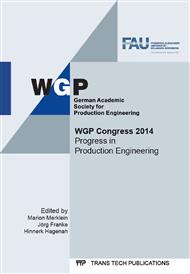[1]
V. Salfeld, R. Krimm, S. Hübner, T. Matthias, M. Vucetic, Sheet-Bulk Metal Forming of Symetric and Asymetric Parts, In: Advanced Materials Research Vol. 769, Trans Tech Publications, Switzerland, 2013, pp.229-236.
DOI: 10.4028/www.scientific.net/amr.769.229
Google Scholar
[2]
R. Plettke, S. Opel, Investigations on orbital forming of sheet metals to manufacture tailored blanks with a defined sheet thickness variation, In: Advanced Materials Research Vol. 769, , Trans Tech Publications, Switzerland, 2013, pp.157-164.
DOI: 10.4028/www.scientific.net/amr.769.157
Google Scholar
[3]
M. Merklein, J. Koch, S. Opel, T. Schneider, Fundamental investigations on the material flow at combined sheet and bulk metal forming processes, CIRP Annals – Manufacturing Technology, Issue 60, 2011, pp.283-286.
DOI: 10.1016/j.cirp.2011.03.146
Google Scholar
[4]
K. Lange, M. Kammerer, K. Pöhlandt, J. Schöck, Fließpressen, 1. Edition, Berlin, Springer, (2008).
DOI: 10.1007/978-3-540-30910-9
Google Scholar
[5]
B. Denkena, D. Boehnke, L. de León, Machining induced residual stress in structural aluminum parts, Production Engineering, Volume 2, Issue 3, 2008, pp.247-253.
DOI: 10.1007/s11740-008-0097-1
Google Scholar
[6]
B. Denkena, B. Breidenstein, Depth resolved residual stress measurements of coated carbide cutting inserts, In: Proceedings of 5th International Conference THE, Coatings in Manufacturing Engineering; EEΔM, Aristoteles University of Thessaloniki and PCCM, 2005: pp.285-294.
Google Scholar
[7]
M. Merklein, K. Andreas, U. Engel, Influence of machining process on residual stresses in the surface of cemented carbides, 1th CIRP Conference on Surface Integrity (CSI), Procedia Engineering 19, 2011, p.252 – 257.
DOI: 10.1016/j.proeng.2011.11.108
Google Scholar
[8]
B. Denkena, L. de Leon, A. Turger, L. Behrens, Prediction of contact conditions and theoretical roughness in manufacturing of complex implants by toric grinding tools, International Journal of Machine Tools & Manufacture 50, 2010, pp.630-636.
DOI: 10.1016/j.ijmachtools.2010.03.008
Google Scholar
[9]
W. S. Lau, M. Wang, W. B. Lee, A simple method of eliminating residual tensile stresses in the grinding of low carbon steels, International Journal of Machine Tools and Manufacture, Volume 31 No. 3, 1991, pp.425-434.
DOI: 10.1016/0890-6955(91)90087-j
Google Scholar
[10]
C. Eichenseer, I. Wittmann, C. Hartig, G. A. Schneider, N. Schell, W. Hintze, In situ measurement of lattice strains in mixed ceramic cutting tools under thermal and mechanical loads using synchrotron radiation, Production Engineering, Volume 7, Issue 2-3, 2013, pp.283-289.
DOI: 10.1007/s11740-012-0426-2
Google Scholar
[11]
M.D. Taylor, K.S. Choi, X. Sun, D.K. Matlock, C.E. Packard, L. Xu, F. Barlat, Correlations between nanoindentation hardness and macroscopic mechanical properties in DP980 steels, Materials Science & Engineering A, Issue 597, Amsterdam, Elsevier, 2014, pp.431-439.
DOI: 10.1016/j.msea.2013.12.084
Google Scholar
[12]
B. Eigenmann, E. Macherauch, Röntgenographische Untersuchungen von Spannungszuständen in Werkstoffen, Teil I, Materialwissenschaft und Werkstoffstechnik. Issue 3, 1995, pp.148-160.
DOI: 10.1002/mawe.19950260310
Google Scholar
[13]
B. Eigenmann, E. Macherauch, Röntgenographische Untersuchungen von Spannungszuständen in Werkstoffen, Teil III, Materialwissenschaft und Werkstoffstechnik. Issue 9, 1996, pp.426-437.
DOI: 10.1002/mawe.19960270907
Google Scholar
[14]
B. Breidenstein, Oberflächen und Randzonen hoch belasteter Bauteile, Berichte aus dem IFW Issue 11, ed. Berend Denkena, Garbsen, Produktionstechnisches Zentrum Hannover GmbH, (2011).
Google Scholar


